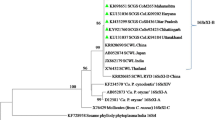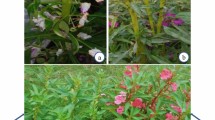Abstract
Symptoms of excessive shoot proliferation were observed in the Njallani cultivar of small cardamom accompanied by stunting of stalks with fewer degenerated capsules at Nedumkandam Panchayat of Idukki district of Kerala in 2017. Five symptomatic Elettaria cardamomum shoot proliferation (ECSP) plant samples were collected and processed for DNA extraction and PCR assays utilizing universal phytoplasma 16S ribosomal-specific primers pair, P1/P7 followed by R16F2n/R16R2. Sequence comparison analysis of the R16F2n/R16R2 region of 16SrRNA gene showed 100% sequence identity with the ‘Candidatus Phytoplasma australasia’- related strain. Phylogeny and virtual RFLP analyses of 16S rRNA gene sequences confirmed the association of ‘Ca. P. australasia’ strain subgroup D with ECSP disease. The association of 16SrII group was further established and validated by amplifying phytoplasma-specific multilocus candidate genes by utilizing specific primers of secA, secY, SAP11, and tuf genes. The multilocus gene sequence comparison analysis again confirmed the association of ‘Ca. P. australasia’ with the ECSP phytoplasma isolate. This is the first report of phytoplasma association with small cardamom.



Similar content being viewed by others
References
Adkar-Purushothama CR, Casati P, Quaglino F, Durante G, Bianco PA (2009) First report of a ‘Candidatus Phytoplasma asteris’-related strain associated with a yellows disease of black pepper (Piper nigrum) in India. Plant Pathol 58:789
Ahrens U, Seemüller E (1992) Detection of DNA of plant pathogenic mycoplasma like organisms by a polymerase chain reaction that amplifies a sequence of the 16S rRNA gene. Phytopathology 82:828–832
Al-Subhi AM, Hogenhout SA, Al-Yahyai RA, Al-Sadi AM (2018) Detection, identification, and molecular characterization of the 16SrII-D phytoplasmas infecting vegetable and field crops in Oman. Plant Dis 102:576–588
Anonymous (2018) Spices Board, Ministry of Commerce and Industry, Government of India
Arocha Y, Piñol B, Picornell B, Almeida R, Jones P, Boa E (2006) Basil little leaf: a new disease associated with a phytoplasma of the 16SrI (Aster Yellows) group in Cuba. Plant Pathol 55:822
Bhai RS, Thomas J (2003) Diseases of cardamom (fungal, bacterial and nematode diseases). In: Ravindran PN, Madhusoodanan KJ (eds) cardamom. CRC Press, Florida, pp 176–195
Bhat AI, Madhubala R, Hareesh PS, Anandaraj M (2006) Detection and characterization of the phytoplasma associated with a phyllody disease of black pepper (Piper nigrum L.) in India. Sci Hortic 107:200–204
Bhat AI, Jiby MV, Anandaraj M, Bhadramurthy V, Patel KD, Patel NR, Agalodia AV (2008) Occurrence and partial characterization of a phytoplasma associated with phyllody disease of fennel (Foeniculum vulgare Mill.) in India. J Phytopathol 156:758–761
Choueiri E, Salar P, Jreijiri F, Zammar El, Massaad S, Abdul-Nour H, Foissac X (2007) Occurrence and distribution of ‘Candidatus Phytoplasmatrifolii’ associated with diseases of solanaceous crops in Lebanon. Eur J Plant Pathol 118:411–416
Deng S, Hiruki C (1991) Amplification of 16S rRNA genes from culturable and nonculturable mollicutes. J Microbiol Methods 14:53–61
Galdeano E, Guzmán FA, Fernández F, Conci LR (2013) Genetic diversity of 16SrIII group phytoplasmas in Argentina. Predominance of subgroups 16SrIII-J and B and two new subgroups 16SrIII-W and X. Eur J Plant Pathol 137:753–764
Gundersen DE, Lee IM (1996) Ultrasensitive detection of phytoplasmas by nested-PCR assays using two universal primer pairs. Phytopathol Mediterrenea 35:144–151
Hall TA (1999) BioEdit: a user-friendly biological sequence alignment editor and analysis program for Windows 95/98/NT. Nucleic Acids Symp Ser 41:95–98
Hodgetts J, Boonham N, Mumford R, Harrison N, Dickinson M (2008) Phytoplasma phylogenetics based on analysis of secA and 23S rRNA gene sequences for improved resolution of candidate species of ‘Candidatus Phytoplasma’. Int J Syst Evol Microbiol 58:1826–1837
Khan MS, Raj SK (2006) First report of molecular detection of an Aster yellows phytoplasma isolate infecting chilli (Capsicum annuum) in India. Plant Pathol 55:822
Kumar S, Stecher G, Tamura K (2016) MEGA 7: molecular evolutionary genetics analysis version 7.0 for bigger datasets. Mol Biol Evol 33:1870–1874
Lebsky V, Hernandez-Gonzalez J, Arguello-Astorga G, Cardenas-Conejo Y, Poghosyan A, Bertaccini A, Maini S (2011) Detection of phytoplasmas in mixed infection with begomoviruses: a case study of tomato and pepper in Mexico. Bull Insectol 64:55–56
Lee IM, Bottner-Parker Zhao K D, Davis RE, Harrison NA (2010) Phylogenetic analysis and delineation of phytoplasmas based on secY gene sequences. Int J Syst Evol Microbiol 60:2887–2897
Randall JJ, Bosland PW, Hanson SF (2009) Brotegrande, a new phytoplasma-associated disease of Chile peppers. Plant Dis 93:968
Rao GP, Reddy MG, Mishra S, Panda P (2018) First report of ‘Candidatus Phytopalsma asteris’ subgroup 16SrI-B association with a witches’ broom disease of fennel. Phytopathogenic Mollicutes 8:102–105
Siddiqui MA, Akram M, Mohiddin FA, Haque Z (2019) Bio-intensive approaches for management of pests and diseases in small cardamom and black pepper. In: Khan MR, Mukhopadhyay AN, Pandey RN, Thakur MP, Singh D, Siddiqui MA, Akram M, Mohiddin FA, Haque Z (eds) Bio-intensive approaches: application and effectiveness in the management of plant nematodes, insects and weeds. Today and Tomorrow’s Printers and Publishers, New Delhi, pp 549–585
Yang Y, Jiang L, Che HY, Cao XR, Yang JY, Sang LW, Luo DQ (2016) Molecular identification of a 16SrII-A group related phytoplasma associated with cinnamon yellow leaf disease in China. J Phytopathol 164:52–55
Zhao Y, Wei W, Lee M, Shao J, Suo X, Davis RE (2009) Construction of an interactive online phytoplasma classification tool, iPhyClassifier, and its application in analysis of the peach X-disease phytoplasma group (16SrIII). Int J Syst Evol Microbiol 59:25
Acknowledgements
The authors extend their gratitude to the Indian Council of Agricultural Research, New Delhi, India, for providing financial assistance during the course of the study. The authors wish to express their sincere thanks to the Head, Division of Plant Pathology and the Directors of Indian Agricultural Research Institute and National Centre for Microbial Resource, Pune for providing laboratory facilities.
Author information
Authors and Affiliations
Contributions
SM did the analytical work of processing samples for DNA extraction, PCR assays and sequence submission. SM did the analysis of sequences for the identification of phytoplasma strain on small cardamom. NSR helped in survey and collection of samples and recordi9nf incidence of the disease. AY helped in sequencing of phytoplasma isolates. GPR helped in preparing and editingthe ms and analyzing sequence data.
Corresponding author
Ethics declarations
Conflict of interest
No conflict of interest.
GenBank submission
All the 16Sr, secA, secY, tuf and SAP11 gene sequences have been submitted in GenBank and appeared in public database.
Electronic supplementary material
Below is the link to the electronic supplementary material.
13205_2019_1944_MOESM1_ESM.jpg
Supplementary Fig. 1 Agarose gel electrophoresis of PCR assay results from small cardamom plants with primer pairs (a) R16F2n/R16R2; M: ladder; N: negative; P: Chickpea phyllody phytoplasma; Lane 1-5: symptomatic ECSP isolates; Lane 6: negative; (b) SecAfor5/SecARev2; M: ladder; N: negative; P: Chickpea phyllody phytoplasma; Lane 1-2: symptomatic ECSP isolates; (c) SecYF2 (II)/SecYR1 (II); M: ladder; P: Chickpea phyllody phytoplasma; Lane 1- 2: symptomatic ECSP isolates; N: negative; (h) TUF-II-F2/ TUF-II-R1; M: ladder; Lanes 1-2: symptomatic ECSP isolates; N: negative control; P: Chickpea phyllody phytoplasma; (e) SAP11(II)DF2/ SAP11(II)DR2; M: ladder; P: Chickpea phyllody phytoplasma; Lanes 1-2: symptomatic ECSP isolates; N: negative (JPEG 202 kb)
13205_2019_1944_MOESM2_ESM.jpg
Supplementary Fig. 2 Phylogenetic tree constructed by neighbor-joining method of (a) secA, (b) secY, (c) tuf and (d) SAP11 gene sequences from 16SrII-D subgroup reference phytoplasma strains and isolates of Elettaria cardamomum shoot proliferation (ECSP) phytoplasma isolates (black triangles). Accession numbers are specified in the tree. Numbers on branches are bootstrap values obtained for 1000 bootstrap replicates. The bar represents a phylogenetic distance of 0.050, 0.20, 0.50 and 0.50 respectively (JPEG 375 kb)
Rights and permissions
About this article
Cite this article
Mishra, S., Mitra, S., Radhika, N.S. et al. Multilocus gene-specific characterization of ‘Candidatus Phytoplasma australasia’ associated with shoot proliferation disease of small cardamom in India. 3 Biotech 9, 420 (2019). https://doi.org/10.1007/s13205-019-1944-9
Received:
Accepted:
Published:
DOI: https://doi.org/10.1007/s13205-019-1944-9




